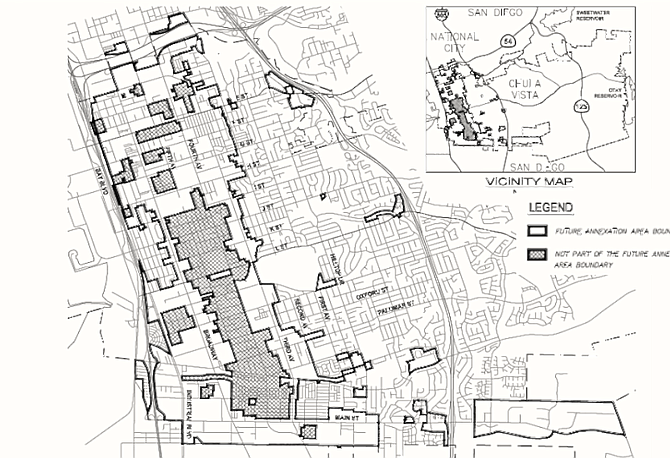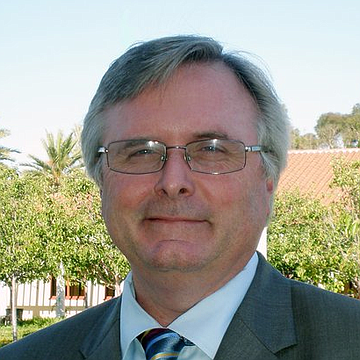 Facebook
Facebook
 X
X
 Instagram
Instagram
 TikTok
TikTok
 Youtube
Youtube

On February 9 the Chula Vista City Council declared their intent to form the first Community Facility District on the western side of the city. The city proposes to use this district and the deferment of developer impact fees to revitalize western Chula Vista.
Community Facility Districts were ushered in after Proposition 13, which limited local agencies’ ability to impose property taxes. The Facility Districts enable developers to raise money for developments; the debt is then passed on to home buyers through the Mello-Roos tax.
Most residents on the east side of Chula Vista bought into a Community Facility District when they purchased their homes, and many have groaned under the additional burden of the Mello-Roos tax.
In addition to creating a Community Facilities District 17-1, the city is proposing that developers receive a ten-year deferral of development impact fees. The proposed deferments include public facilities fees, park acquisition fees, and transportation development impact fees. These fees are normally used to offset the impact of new development by acquiring park land and upgrading roads.
Economic development director Eric Crockett offered this rationale for fee deferral:
“We’ve seen a lot of activity in western Chula Vista…but we’re not seeing a lot going vertical. There are really no comparables to satisfy the lenders, so the lenders are requiring additional equity from developers, which is lowering the return, which is making it less attractive to developers to get vertical.”

City manager Gary Halbert further clarified the proposal on February 22:
“This was geared toward a more holistic approach to create opportunities in western Chula Vista. The essence is to put a blank canvas of a [Community Facility District] over the commercial, industrial, and high-density residential districts in western Chula Vista. It doesn’t put anybody into that district; rather, it allows for future annexations on a parcel-by-parcel basis. So, if a developer comes forward and wants the fee deferral, then puts the fee onto the tax rolls through a Mello-Roos district, they’re doing it completely voluntarily.
“Ten years seems to be the sweet spot for refinancing projects, so it gives [developers] the ability to go ahead, at the ten-year mark, to pay off these fees as part of the refinancing of the project, or roll it over onto the tax roll. In no case would anybody [owner/developer of a parcel] be in a situation where they were forced into a Mello-Roos district.”

Councilmember Patricia Aguilar provided additional clarification:
“The [Community Facility District] lasts 30 years because that is the typical amount of time used to finance property purchases through a mortgage. For those developers who want to take advantage of the program, the special Mello- Roos tax shifts the burden of paying developer impact fees from the developer to the future property owner. But the future property owner [and their lender] would by law be informed, and would take that into consideration when deciding whether to purchase the property. If the buyer decides to purchase, they would not have to pay any of the ‘tax’ for 10 years. But they would have to start paying in year 11, and would have to be finished paying it by year 30.”
Regarding the fee deferral, Aguilar said:
“What is being proposed is a program that would, with city council approval, postpone the city’s collection of developer impact fees in parts of the west side for 10 years. The program would last at least 5 years. So, that means that for at least 15 years the city would not collect sufficient funds to pay for new public improvements, such as a new library or fire-station space, new roads, or new parks, necessary to service whatever development occurs. Given the slow rate of development on the west side, you could argue that there probably won't be enough new development to generate a need for new library space or fire station space, or new roads.
“But parks are at the heart of my concern. Given that the west side is already behind where it should be in park space, deferment of the park acquisition and development fee worries me. That is why I need to see a fiscal analysis for this proposal. I need to understand how this might affect what the public service needs are on the West side.”
Staff will provide a fiscal analysis by March 15. There will be a public hearing on the proposal at 5:00 p.m. Interested persons may appear before the council; written protests should be filed on or before that time.
The Southwest Civic Association will hold a forum on the proposed west side Community Facility District February 29 @ 6:00 in the South Chula Vista library. City Manager Gary Halbert will speak and District 4 candidates will be introduced.


On February 9 the Chula Vista City Council declared their intent to form the first Community Facility District on the western side of the city. The city proposes to use this district and the deferment of developer impact fees to revitalize western Chula Vista.
Community Facility Districts were ushered in after Proposition 13, which limited local agencies’ ability to impose property taxes. The Facility Districts enable developers to raise money for developments; the debt is then passed on to home buyers through the Mello-Roos tax.
Most residents on the east side of Chula Vista bought into a Community Facility District when they purchased their homes, and many have groaned under the additional burden of the Mello-Roos tax.
In addition to creating a Community Facilities District 17-1, the city is proposing that developers receive a ten-year deferral of development impact fees. The proposed deferments include public facilities fees, park acquisition fees, and transportation development impact fees. These fees are normally used to offset the impact of new development by acquiring park land and upgrading roads.
Economic development director Eric Crockett offered this rationale for fee deferral:
“We’ve seen a lot of activity in western Chula Vista…but we’re not seeing a lot going vertical. There are really no comparables to satisfy the lenders, so the lenders are requiring additional equity from developers, which is lowering the return, which is making it less attractive to developers to get vertical.”

City manager Gary Halbert further clarified the proposal on February 22:
“This was geared toward a more holistic approach to create opportunities in western Chula Vista. The essence is to put a blank canvas of a [Community Facility District] over the commercial, industrial, and high-density residential districts in western Chula Vista. It doesn’t put anybody into that district; rather, it allows for future annexations on a parcel-by-parcel basis. So, if a developer comes forward and wants the fee deferral, then puts the fee onto the tax rolls through a Mello-Roos district, they’re doing it completely voluntarily.
“Ten years seems to be the sweet spot for refinancing projects, so it gives [developers] the ability to go ahead, at the ten-year mark, to pay off these fees as part of the refinancing of the project, or roll it over onto the tax roll. In no case would anybody [owner/developer of a parcel] be in a situation where they were forced into a Mello-Roos district.”

Councilmember Patricia Aguilar provided additional clarification:
“The [Community Facility District] lasts 30 years because that is the typical amount of time used to finance property purchases through a mortgage. For those developers who want to take advantage of the program, the special Mello- Roos tax shifts the burden of paying developer impact fees from the developer to the future property owner. But the future property owner [and their lender] would by law be informed, and would take that into consideration when deciding whether to purchase the property. If the buyer decides to purchase, they would not have to pay any of the ‘tax’ for 10 years. But they would have to start paying in year 11, and would have to be finished paying it by year 30.”
Regarding the fee deferral, Aguilar said:
“What is being proposed is a program that would, with city council approval, postpone the city’s collection of developer impact fees in parts of the west side for 10 years. The program would last at least 5 years. So, that means that for at least 15 years the city would not collect sufficient funds to pay for new public improvements, such as a new library or fire-station space, new roads, or new parks, necessary to service whatever development occurs. Given the slow rate of development on the west side, you could argue that there probably won't be enough new development to generate a need for new library space or fire station space, or new roads.
“But parks are at the heart of my concern. Given that the west side is already behind where it should be in park space, deferment of the park acquisition and development fee worries me. That is why I need to see a fiscal analysis for this proposal. I need to understand how this might affect what the public service needs are on the West side.”
Staff will provide a fiscal analysis by March 15. There will be a public hearing on the proposal at 5:00 p.m. Interested persons may appear before the council; written protests should be filed on or before that time.
The Southwest Civic Association will hold a forum on the proposed west side Community Facility District February 29 @ 6:00 in the South Chula Vista library. City Manager Gary Halbert will speak and District 4 candidates will be introduced.
Comments